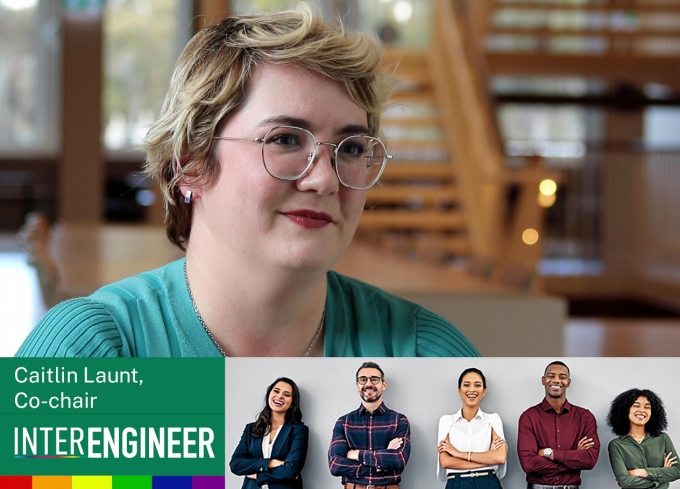To mark the 4th International Day of LGBTQIA+ People in STEM, we interviewed Caitlin Launt of InterEngineer, who offered strategies for “active allyship,” and for fostering and recruiting diversity in STEM. She also shared personal stories that illustrate how people in the LGBTQIA+ community experience the workplace.
Launt said that she did not come out until after university, and that she has since grown comfortable being her authentic self in work environments. As a woman who identifies as queer but does not look or carry herself according to popular stereotypes, she said she is “forever coming out” in her professional life. “I find myself constantly coming out and there’s always a wonder of, ‘Should I? Is this person actually safe to do this will I get a reaction that I want?’”
In her current job at Icon Water, most of the engineers on her team are women. “I’m actually in a team of five and a broader team of about 12. And in my team there is one male engineer out of five, and in my broader team there are three male engineers.”
“I’ve been very lucky particularly in the water industry,” Launt said. “I’ve been very lucky finding jobs and working for people who are exceptionally open who, when I’ve told them these things, have just not cared. They’ve gone, ‘Okay cool that’s great, thank you for sharing that, but also the work.”
“The argument for diversity isn’t necessarily just about diversity for diversity’s sake, like we’re not trying to check a box, we’re not trying to be more woke,” Launt said. “There are real tangible engineering benefits for us if we are, not only working in diverse teams, but also exposed to people of diverse backgrounds. For example, if you’re trying to design something, if you’ve only got your own set of experiences or sets of experiences like yours to draw from in building, then you don’t understand the problem. And if you don’t understand the problem fully, you’re not going to get a good product.” InterEngineer and Engineers Australia ————————————-
InterEngineer was spawned from a conversation between co-chair Matthe Tendam and the diversity inclusion coordinator at Engineers Australia. Engineers Australia is a founding partner and hosts web pages for InterEngineer, but Launt made clear that InterEngineers is not an Engineer’s Australia community or network.
“We didn’t want membership of Engineers Australia to be a pre-qualifier for joining the community,” she said. “It’s open to students, it’s open to staff, it’s open to engineers and their allies to share experiences and advocate and network together.”
Launt dedicates her time to InterEngineer in order to ensure that other members of the LGBTQIA+ community also have positive experiences in the engineering field. She said students are a “vulnerable cohort,” and that one of their main focuses is LGBTQIA+ engineers who are transitioning from academia to the workplace.
Launt said that InterEngineer also wants to reach out to and provide a network for LGBTQIA+ engineers working in regional areas. “I think they are more affected by that isolation and more affected by this idea of being the only gay in the village, because in a small town you might actually be the only gay in the village,” she said.
Launt recalled working in regional areas in Western Australia, where she would visit small towns along with her boss, who was a male engineer. Launt recalled sensing “a split second” of hesitation from men upon first meeting her and shared how she learned to diffuse the tension.
“Because of who I am what I look like, I tend to be the one who walks up to people and says ‘Hi I’m Caitlin, I’m one of the engineers’ and introduce myself holding out my hand,” she said, leaning forward and demonstrating how she offers a confident, gender-neutral handshake to men who might be more accustomed to greeting women with a hug or a kiss.
Best practices
For academic as well as workplace environments, Launt says that fostering a welcoming community begins at the hiring and recruiting stage. She recommends making clear in job advertisements that your organisation is welcoming and inclusive, which can improve the diversity of applicants.
“If you make your workplace generally more psychologically safe, by default you’re going to be making it more inclusive to people who have diverse backgrounds or who are diverse identities,” Launt said.
“Everybody brings work home, and home to work. You wouldn’t want to keep details about your partner or your kids or your hobbies or any of those things quiet at work, and being able to be your full authentic self at work is actually one of the things that makes things safer.”
Launt recommended staying aware and conscious of gender implications in language choices (referring to groups of people as “folks” rather than “gents” or “guys”) and having rainbow imagery visible in the office to promote a welcoming environment.
“Things like putting your pronouns on your email signature can be a really helpful one, not because I necessarily need to know your pronouns, but because it signals to me that you’ve at least thought about it, and you’ve at least turned around and said, ‘Okay, yeah, this is probably something that’ll be helpful for someone who’s gender diverse, so I’m going to do that.’”
Launt said that workplaces can help foster a more welcoming environment by providing resources and training, as well as surveying demographic information to better understand the makeup of collabortive teams the industry at large.
___
There are three ways that you can get involved in InterEngineer as an LGBTQIA+ engineer or ally; follow the LinkedIn page, join the LinkedIn group and sign up to the mailing list to hear about InterEngineer events. If you would like more detail on the InterEngineer initiative, please contact diversity@engineersaustralia.org.au.
**QLife provides Australia-wide anonymous, LGBTQIA+ peer support and referral.

